Erica verticillata
Erica verticillata P.J.Bergius
Family: Ericaceae
Common names: whorled heath, marsh heath
Introduction
How could a plant as hardy and strikingly beautiful as Erica verticillata have been allowed to reach the precipice of extinction? Fortunately the story of Erica verticillata is a heartening tale of successful ex situ conservation and is, with the help of Kirstenbosch horticulturists and Table Mountain National Park conservation staff, in the process of reclaiming its position in nature through restoration programs.
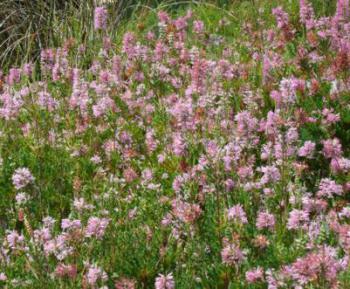
Description
Description
Erica verticillata is a handsome, strong growing, hardy species averaging between 1.5 and 2 m in height, but old specimens have been recorded to grow up to 3 m tall. It produces beautiful pink, tubular flowers arranged in neat whorls organised in distinct groups up the principal stems and near the tips of sturdy branches. Peak flowering is from January to March, but this species produces some flowers intermittently throughout the year. It has been observed that inflorescences produced outside of the main flowering season are not as handsome as those produced during peak flowering as they tend to be arranged in a less orderly manner.
There are eight cultivars of Erica verticillata at Kirstenbosch Botanical Garden. Each collection is recorded in the Kirstenbosch plant records database with a unique accession number. The various forms have also been endorsed with cultivar names and numbers by the international registrar of erica cultivar names, Dr Charles Nelson. See below for details. (Please do not be misled by the heading below, these cultivars not species.)
See History of the loss and rediscovery of Erica verticillata for more details of the history of these cultivars.
Conservation Status
Status
The story of Erica verticillata is unique in the annals of plant conservation in South Africa. It was regarded as extinct in the wild, or âe~perhaps exterminated' (Adamson & Salter 1950), by the second half of the 20th century. It was rediscovered in a park in Pretoria in 1984 and, since then, in various botanical gardens around the world and brought back into cultivation at Kirstenbosch Botanical Garden. The species has become one of Kirstenbosch's flagship conservation species and has been re-established to three Sand Plain Fynbos reserves within the urban sprawl of Cape Town. These include Rondevlei Nature Reserve, Kenilworth Racecourse Conservation Area and the Tokai Park under management of the South African National Parks. Its status remains Extinct in the Wild and will be re-assessed when it has survived three burn cycles in the wild without restocking or replanting.
See History of the loss and rediscovery of Erica verticillata for the full story of the rediscovery and restoration of this species.
Distribution and habitat
Distribution description
Erica verticillata used to grow in Sand Plain Fynbos on the Cape Flats of the Cape Peninsula from the Black River to Zeekoevlei (Oliver & Oliver 2000). Herbarium records indicate that it grew in a narrow band between Main Road and the M5 freeway. It is recorded from the Black River cottages near Mowbray in the north, at Rondebosch, Newlands, Claremont, Kenilworth, Wynberg and as far south as Zeekoevlei. The rather sketchy information on herbarium sheets and in the literature suggests that this species preferred seasonally damp, acid, sandy soils near rivers and wetlands. Agricultural and urban development, that occurred as colonial Cape Town expanded, resulted in the destruction of its natural habitat and it was also reduced by picking for the flower seller's market.
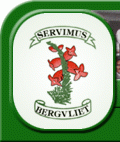
It is interesting to note that E. verticillata appears on the Bergvliet Primary School badge. The school is situated near the Diep River in the suburb of Bergvliet, which is between Wynberg and Zeekoevlei and therefore falls within the distribution range.
Derivation of name and historical aspects
History
The genus Erica gets its name from ereiko, to break, either because of the ability of the plant to break up bladder stones or more probably because the stems are brittle and break easily. The specific epithet verticillatus is descriptive of the whorled arrangement of the leaves and flowers, i.e. they are arranged in a circle around the stem, from the Latin verticis, of a whirlpool or vortex (i.e. the genitive case of vertex ).
Coming from the sandy flats near the earliest Cape settlement this species was collected by some of the earliest plant collectors. Bergius in his protologue made only one citation—‘HERM Afr. 8', presumably a specimen collected by the German, Paul Hermann, when he made the first herbarium collections at the Cape in 1672 (Gunn & Codd 1981). This specimen has not been found. Until such time as it is found, a new, replacement type was selected and this very good specimen was the specimen in Bergius' own herbarium given to him by Michael Grubb, a director of the Swedish East India Company who bought his collections from the resident German gardener, Johann Auge, on calling at the Cape from the Far East in 1764 (Gunn & Codd 1981).
Bergius' name was overlooked by Solander when he described Erica concinna in 1789 based on a collection made by Francis Masson. This name persisted in English literature until Guthrie & Bolus (1905) realised that it was the same species as Bergius's Erica verticillata.
The History of the loss and rediscovery of Erica verticillata is a fascinating story and we have created an extra page to do it justice.
Ecology
Ecology
Erica verticillata is a narrow endemic, which means that it had a very limited distribution. It grew in seasonally moist sandy habitats or along stream banks on the Cape Flats of the southern suburbs of Cape Town. Its vegetation type is called Sand Plain Fynbos. The soils it grew in were sandy, well drained, nutrient deficient and acidic. Like other ericas it depended upon a symbiotic association with micorrhiza fungi to survive the trials of hot dry summers. The fungus enters the roots of the erica and sends out a network of hyphae strands that increase the water-absorbing capacity of the plant even during dry periods. The flowers attract sunbirds, bumblebees, hawk moths, bees and beetles that come to sip the nectar the flowers provide.
Uses
Use
Erica verticillata is a very showy and easy-to-grow erica. It was harvested as a cut flower from its natural habitat by flower sellers until it could no longer be found. It is now a popular garden plant or pot plant that attracts sunbirds.
Growing Erica verticillata
Grow
Erica verticillata is one of the relatively few reliable South African ericas that is comparatively hardy, disease resistant and recommended for planting in both gardens and containers. It is one of the easiest ericas to grow from cuttings. Heel cuttings are selected from fresh side shoots usually taken in autumn, but they have been rooted throughout the year at Kirstenbosch. They should preferably be rooted in multi-trays in a medium consisting of equal parts 6 mm milled pine bark and polystyrene or perlite chips under mist and on heated propagation benches. Rooting is enhanced by using a powder-based rooting hormone for semi-hardwood cuttings or by dipping the base of the cutting for five seconds in 2000 ppm IBA solution. Rooting takes from three to six weeks. Once the cuttings are well rooted they are removed from the propagation benches and placed on hardening off benches away from bottom heat or mist. At this stage they should be fed with diluted (50%) liquid, organic seaweed-based fertilizers.
Rooted cuttings are planted and established in a well-draining potting mix such as that developed at Kirstenbosch for fynbos plants. The mixture consists of equal parts composted pine bark or pine needles and acidic river sand. Welldecomposed compost will be suitable so long as it has been naturally composted and does not contain additives such as manure.
Erica verticillata does not readily produce seed unless two or more different clones of this species are in relatively close proximity for intraspecific cross pollination to take place. The surviving collections do not produce a lot of seed when compared with most other ericas. E. verticillata cultivars 'African Phoenix' and 'Adonis' appear to produce the most seed of the remaining collections at Kirstenbosch.
The seed should preferably be sown in late summer or autumn within the first three years of production, after which most erica seeds appear to gradually lose viability. Seed is sown in seed trays on the top of the fynbos potting mixture, lightly covered with sand, and then subjected to smoke treatment before the trays are watered. This allows for maximum smoke penetration into the medium containing the seed. Smoke is generated in a drum using dry and semi-dry fynbos plant material and is pumped into a sealed plastic tent stretched over a frame containing the trays of erica seed. The smoke is allowed to settle onto the medium, leaving a brownish film, after which the trays are removed from the tent. The seed trays may then be lightly watered, taking care not to disturb the seed. Erica seed germinates approximately three to four weeks after sowing and produces very small cotyledons at the first growth stage. The secondary, ericoid, leaves begin to appear from the eighth to the twelfth week. Seedlings may be pricked out into multi-trays or grow plugs after they have reached 5 mm in height. They should not be planted into too large a container where the soil-to-seedling root ratio is not in balance because the medium remains wet too long and the root zone may become anaerobic.
Once the seedling has filled the grow plug with roots it may be potted on into a larger container. The same rationale should be followed when potting on erica cuttings. Both seedlings and cuttings should be grown on under light shade (40%) until they have become well established in their containers, and only then moved into full sunlight. Plants are grown on to about 100 mm before planting out into the garden. Plants propagated from cuttings taken from mature plants will flower in the first season whereas plants grown from seed usually only flower in their third year.
Erica verticillata performs best when planted in a well ventilated, warm, sunny position. It prefers seasonally moist, well draining, sandy soils, but will grow well in average Mediterranean or warm-temperate garden conditions provided the soils are acidic and the plants are not subject to frost. The best time to plant them in the winter-rainfall areas of South Africa is in autumn or during the winter although they may be planted at other times of the year if regularly watered. The general rule is to plant at the beginning of the rainy season.
Place in a pre-prepared hole with as little disturbance to the root zone as possible. Fill in with the surrounding soil and add pine compost if available. Leave a basin around the plant to help collect water. Mulching is strongly recommended as it keeps the soil surface cool and damp and reduces weed growth. Plants should be well watered after planting and then every two to three days unless good rainfalls occur. Deep watering encourages the roots to penetrate deeper into the soil, which helps the plant survive the hot dry conditions in summer.
Container-grown plants may be kept in a warm, bright and well ventilated position, but will not tolerate indoor conditions. They grow and flower well under conditions up to 40% shading, but heavier shading will result in the plant etiolating and the flower colours becoming washed out.
Pruning is very important and may be practised from early in the development of the plant. Pruning will increase branching and the number of flower-bearing stems and will prolong the life of the plant. Plants pruned regularly from an early stage will produce a lovely full shape. Prune more mature plants only after flowering in order not to cut away new buds. Ericas should be regularly fed with organic liquid fertilizers or control-release fertilizers low in phosphorus. Control-release fertilizers should be applied sparingly, about 10 granules per plant, to balance growth of foliage versus flower production.
Erica verticillata has been known to grow to over 20 years of age at Kirstenbosch and at Rondevlei Nature Reserve although it becomes increasingly woody and senescent after 10 to 15 years' growth. Plants grown in their natural habitat, such as at Rondevlei Nature Reserve, appear to keep their form and condition better, probably because their rate of growth is more measured under natural conditions.
Erica verticillata has very few pest problems. Seedlings may suffer from damping off fungal disease if the seed is sown too thickly, subject to poor ventilation or the soil medium is kept too wet. New growth tips may occasionally be damaged by thrips. These aretiny, slender insects, from the Order Thysanoptera, with fringed wings, that puncture and suck on the softer new growth causing growth distortion and browning of the growth tips. Thrips infestations are easily controlled by applying a pesticide and by pruning and destroying the infected parts of the plant.
Species

Erica verticillata ‘African Phoenix' ( Kirstenbosch no. 536/1984, registered cultivar E. 2012-05)
This specimen comes from Protea Park in Pretoria. It is a tall, erect species growing to an average height of 1.8 m, but old specimens may reach up to 2.5 m tall. The flowers are medium pink, tubular (18 mm long) and arranged in whorls on strong, erect branches.
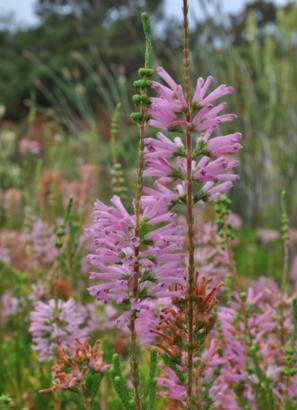
Erica verticillata ‘Belvedere' (Kirstenbosch no. 109/2001, registered cultivar E. 2012-07)
This specimen comes from the Belvedere Palace collection in Vienna and probably originates from collections made by George Scholl between 1796 and 1799. It is a medium-sized, erect species growing to an average height of 1.70 m and 1.0 m wide, but old specimens may reach up to 2.0 m tall. The flowers are tubular, arranged in whorls, light pink and appear translucent in sunlight.
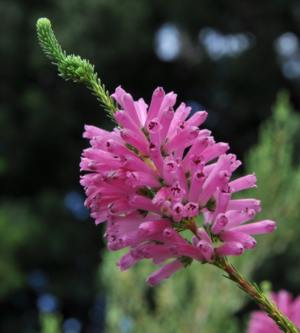
Erica verticillata ‘Adonis' (Kirstenbosch no. 273/12, registered cultivar E. 2012-06) This is the dark pink-flowered plant discovered behind the Braille Trail at Kirstenbosch by senior foreman, Adonis Adonis in 1990, and named in honour of him. It is a medium-sized shrub, smaller and bushier than ‘African Phoenix', growing to an average height of 1.40–1.60 m, but old specimens may reach up to 2.0 m tall. The flowers are dark pink, tubular (20 mm long) and arranged in whorls on the strong, erect main branches. The side branches are shorter and the leaves appear more crowded than with the other cultivars. This gives this form an overall thicker, heavier, bushier appearance.
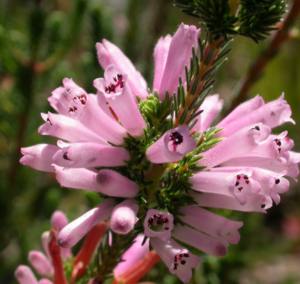
Erica verticillata ‘Louisa Bolus' (Kirstenbosch no. 272/2012 registered as the cultivar E. 2012:12)
This is the light pink form found at Kirstenbosch by Adonis Adonis at the same spot as the ‘Adonis' cultivar. It is named after Louisa Bolus, who originally collected the plants in 1917. The description is the same as for the cultivar Erica verticillata ‘Adonis' except for the flower colour which is light pink.
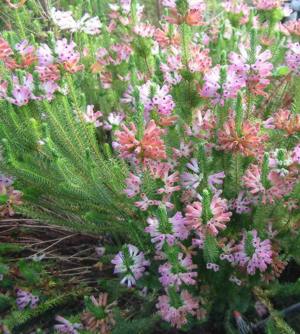
Erica verticillata ‘Tresco Abbey' (Kirstenbosch no. 543/2006, registered cultivar E. 2012-08)
This specimen comes from Tresco Abbey Garden on the Isles of Scilly. It is a smaller rounded form growing to an average height of 0.60 m by 0.5 m wide. The flowers are smaller, arranged in whorls, but fewer than the other forms, medium pink and tubular. ‘Tresco Abbey' is noticeably different from all the other Erica verticillata forms as there are no conspicuous flower-bearing stems, flowers are smaller, the side branching is elongated, erect, reaching almost up to the apex of the shrub.
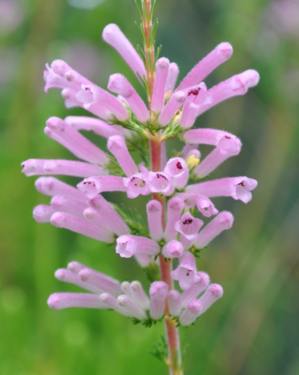
Erica verticillata ‘Doctor Violet Gray' ( Kirstenbosch no. 548/2006, registered cultivar E. 2012-09)
This specimen originates from the erica collection of the late Dr Violet Gray in the United Kingdom. It is a medium-sized, erect form growing to an average height of between 1.0–1.2 m by 0.5 m wide. The flowers are light pink, tubular (20 mm long) and arranged in whorls on strong, erect main branches.

Erica verticillata ‘Harry Wood' (Kirstenbosch no. 657/2006, registered cultivar E. 2012-10)
This specimen originates from the erica collection at the Royal Botanic Gardens Kew who received seed from the late Mr. Harry Wood, Curator of the Fernkloof Nature Reserve in Hermanus, in 1961. It is a medium-sized, erect form growing to an average height of between 1.0–1.20 m by 0.6 m wide. The flowers are light pink, tubular (20 mm long) and arranged in whorls on strong, erect main branches.
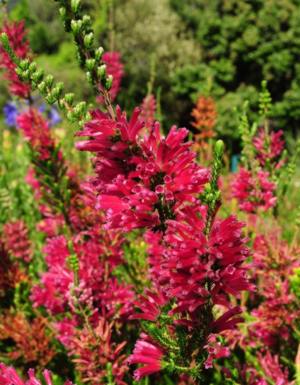
Erica verticillata ‘Cherise' (Kirstenbosch no. 549/2006, registered cultivar E. 2012-11)
This specimen comes from the United States where it was trademarked ‘Ruby Lace' in 1986 by Monrovia Nursery in California. They obtained it from Nurserymen's Exchange, a wholesale nursery in Monterey, California. No further information is available on the history of this form. It is medium-sized and erect, growing to an average height of between 1.0–1.30 m by 0.5–1.0 m wide. The flowers are dark reddish pink, tubular (17 mm long) and arranged in whorls
References
- Adamson, R.S. & Salter, T.M., 1950. Flora of the Cape Peninsula , Juta, Cape Town and Johannesburg.
- Bolus, H., Guthrie, F. & Brown, N.E. 1909. Flora Capensis 4. [run on]
- Lovell Reeve, London.
- Goldblatt, P. & Manning, J.C. 2000. Cape plants. A conspectus of the Cape Flora of South Africa. Strelitzia 9. National Botanical Institute, Pretoria & Missouri Botanical Garden Press, Missouri.
- Hitchcock, A., Cowell,C. & Rebelo, A. [Author: date?]The lost fynbos of Tokai Park. Veld & Flora 98(1): 30âe"33.
- National Botanic Gardens of South Africa: Annual Reports.
- Oliver, I & E.G.H., 2000. Field guide to the ericas of the Cape Peninsula . Protea Atlas Project, National Botanical Institute, Cape Town.
- Raimondo, D., Von Staden, L., Victor, J.E., Helme, N.A., Turner, R.C., Kamundi, D.A. & Manyama, P.A. (eds) 2009. Red List of South African plants 2009. Strelitzia 25. South African National Biodiversity Institute, Pretoria.
- Schumann, D., Kirsten, G. & Oliver, E.G.H. 1992. Ericas of South Africa . Fernwood Press, Cape Town.
- Turner, R. 2009. A year of erica atlassing. Part 1: Erica patens and Erica brachialis . Veld & Flora 95(2): 86âe"89.
- Turner, R. 2010. Sunbird Surprise! Surprises in the world of plant pollination. Full Circle Magazine 17(3): 34.
Credits
Anthony Hitchcock
Kirstenbosch National Botanical Garden
February 2013
Plant Attributes:
Plant Type: Shrub
SA Distribution: Western Cape
Soil type: Sandy
Flowering season: Late Summer, Autumn
PH: Acid
Flower colour: Pink, Mauve/Lilac
Aspect: Full Sun
Gardening skill: Average
Special Features:
Horticultural zones







Rate this article
Article well written and informative
Rate this plant
Is this an interesting plant?
Login to add your Comment
Back to topNot registered yet? Click here to register.